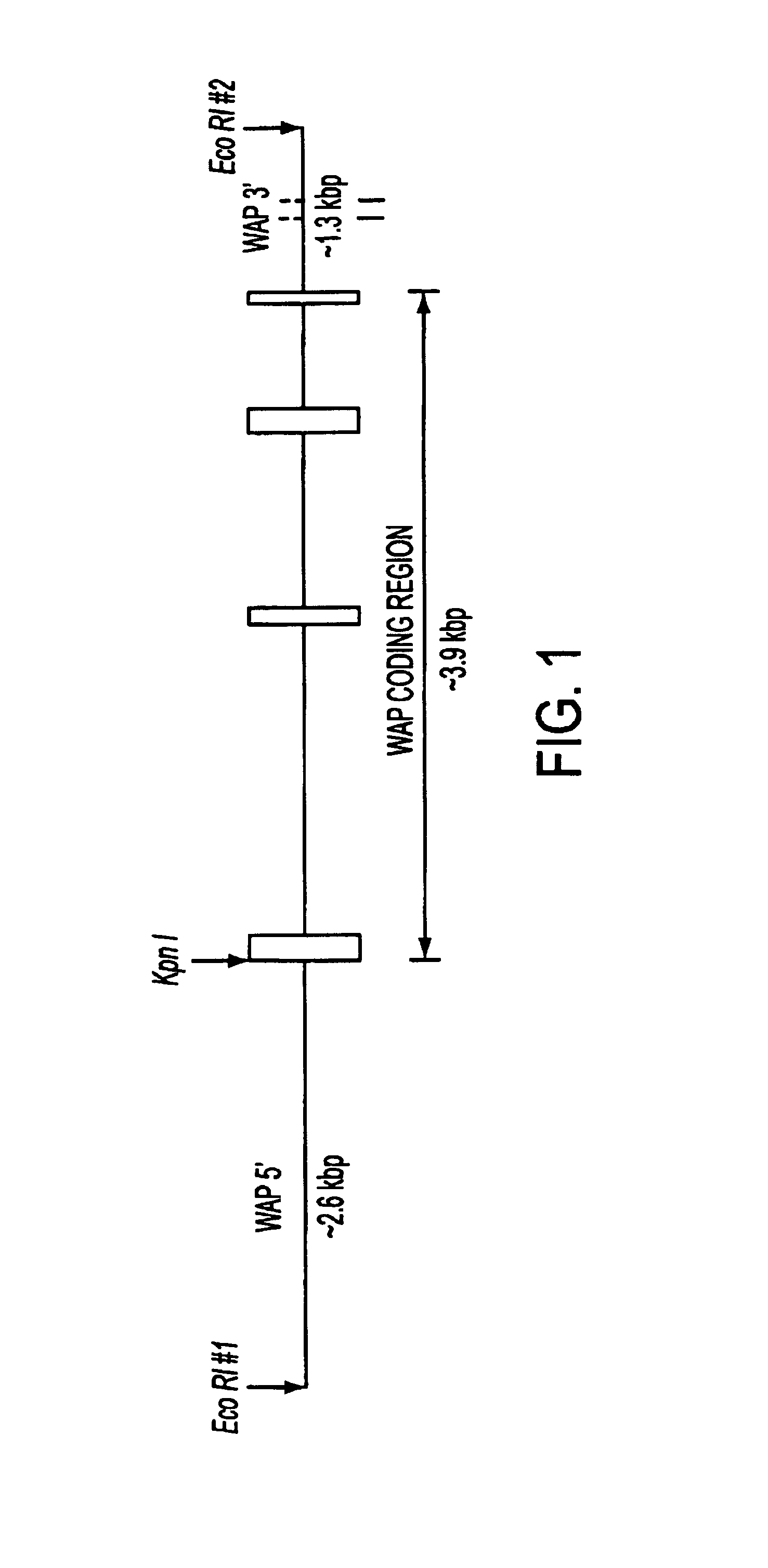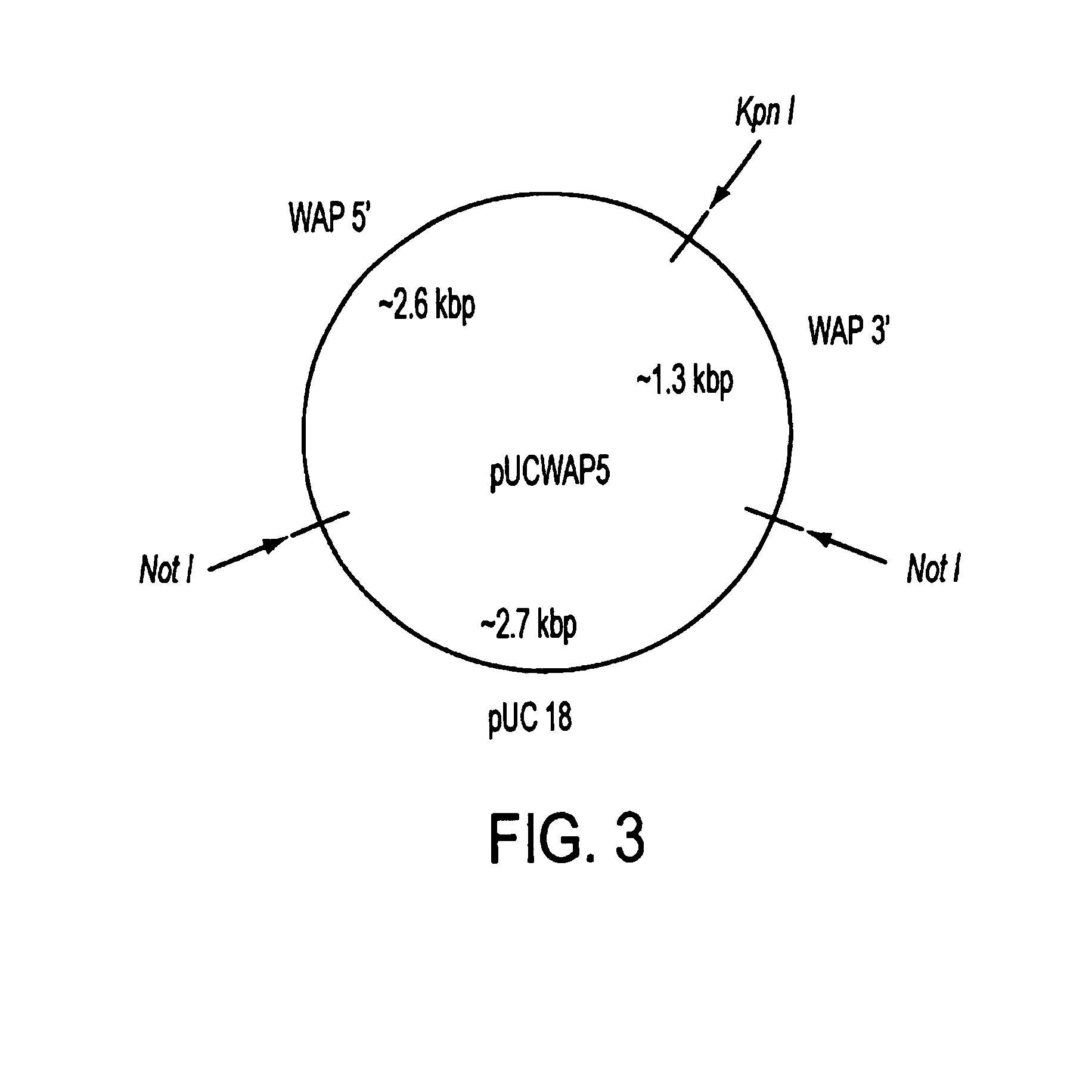Transgenic non-human mammals producing fibrinogen in their milk
a non-human, fibrinogen-producing technology, applied in the field of transgenic animals, can solve the problems of increased treatment cost, increased risk of hepatitis or aids, and increased risk of patients
- Summary
- Abstract
- Description
- Claims
- Application Information
AI Technical Summary
Benefits of technology
Problems solved by technology
Method used
Image
Examples
example 1
WAP-Fibrinogen cDNA Constructs For Expression of Fibrinogen in Transgenic Animals
Construction of Cassette Vectors
[0073]FIB subunit chain DNAs, tissue-specific promoters, and secretion signal sequences were obtained from sources described above. FIB subunit chain cDNAs were cloned into a modified pUC 18 vector, and grown up in E. coli JM109.
[0074]A pUC18 vector (GIBCO-BRL, Gaithersburg, Md.) was digested with HindIII+EcORI restriction endonucleases, blunted with T4 DNA polymerase in the presence of 100 mM dNTPs, and a Not I linker was ligated into the former HindIII-EcORI multiple cloning site. This modified pUC fragment was additionally digested with Not I+enzyme to remove extra (multiple copies) NotI linker sequences arising from ligation, and then religated and grown up in E. coli JM 109. This procedure modified the pUC18 vector by removing the entire multiple cloning region of pUC18 (including the Kpn I site) and replacing it with a Not I restriction site. The new vector was desi...
example 2
Preparation of DNAs for Microinjection
[0079]The intact and linearized WAP 5′ promoter / fibrinogen cDNA / WAP 3′ UTR and flanking fragments were excised from each pUCWAP5 plasmids by NotI restriction endonuclease digestion and purified by low melting point agarose electrophoresis. The DNA:agarose band was cut from the gel slab. The agarose band was then treated with agarase to degrade and remove agarose contamination.
[0080]After digestion, the solution containing the cDNA was brought to 10 mM Mg2+, 20 mM EDTA and 0.1% SDS and then extracted with phenol / chloroform. DNA was precipitated from the aqueous layer with 2.5 volumes of ethanol in the presence of 0.3 M sodium acetate at −20° C. overnight. After centrifugation, the pellet was washed with 70% ethanol, dried, and each of the constructs was resuspended and dissolved in Brinster microinjection buffer to a total (α, β, plus γ) concentration of about 1.2 to 5 μg / ml. Brinster et al., Proc Natl. Acad. Sci. USA 82:4438 (1985), incorporated...
example 3
Transgenic Mice
[0081]Transgenic mice were produced essentially as described by Hogan et al., Manipulating The Mouse Embryo, Cold Spring Harbor Press, 1986, incorporated by reference. The procedures employed are outlined below.
[0082]Glass needles for micro-injection were prepared using a micropipet puller and microforge. Injections were performed using a Nikon microscope having Hoffman Modulation Contrast optics, with Narashigi micromanipulators and a pico-injector driven by N2 (Narashigi).
[0083]Fertilized mouse embryos were surgically removed from the oviducts of superovulated female CD-1 mice and placed into M2 medium. Cumulus cells were removed from the embryos with hyaluronidase at 300 μg / ml. The embryos were then rinsed in new M2 medium, and transferred into M16 medium for storage at 37° C. prior to injection.
[0084]Stock solutions containing about 1.2 μg / ml (having about 0.4 μg / ml each of the linearized constructs containing the Aα, Bβ, and Gγ chains cDNAs for human fibrinogen, ...
PUM
| Property | Measurement | Unit |
|---|---|---|
| total molecular mass | aaaaa | aaaaa |
| concentration | aaaaa | aaaaa |
| concentrations | aaaaa | aaaaa |
Abstract
Description
Claims
Application Information
 Login to View More
Login to View More - R&D
- Intellectual Property
- Life Sciences
- Materials
- Tech Scout
- Unparalleled Data Quality
- Higher Quality Content
- 60% Fewer Hallucinations
Browse by: Latest US Patents, China's latest patents, Technical Efficacy Thesaurus, Application Domain, Technology Topic, Popular Technical Reports.
© 2025 PatSnap. All rights reserved.Legal|Privacy policy|Modern Slavery Act Transparency Statement|Sitemap|About US| Contact US: help@patsnap.com



